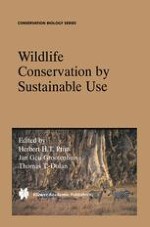2000 | OriginalPaper | Buchkapitel
Wildlife, Livestock and Animal Disease Reservoirs
verfasst von : Jan Geu Grootenhuis
Erschienen in: Wildlife Conservation by Sustainable Use
Verlag: Springer Netherlands
Enthalten in: Professional Book Archive
Aktivieren Sie unsere intelligente Suche, um passende Fachinhalte oder Patente zu finden.
Wählen Sie Textabschnitte aus um mit Künstlicher Intelligenz passenden Patente zu finden. powered by
Markieren Sie Textabschnitte, um KI-gestützt weitere passende Inhalte zu finden. powered by
The perceived risk of disease transmission from wildlife to livestock has led to massive eradication of wildlife in Africa, especially during the first half of this century. There is no evidence in East Africa that this reduction in wildlife has decreased the incidence of livestock disease or the costs of livestock disease control. The few exceptions in which wild animals are a true disease reservoir are discussed in relation to their economic importance. Several examples are given in which domestic animals carry disease and constitute a risk for disease outbreaks in wildlife populations. Data on the economic consequences of disease transmission between livestock and wildlife are almost non-existant. In general, disease risks emanating ]from wildlife have been overestimated. This is an area for research which would be of practical value for land use assessment of mixed wild and domestic animal production. Control of some of the most important cattle diseases is shown not to be cost-effective in semi arid rangelands. Based on economic and conservation goals, it appears to be valuable to re-examine current pressures on land use and to develop sustainable options for change. Such analysis has already favoured the use of wildlife in many southern African countries.
